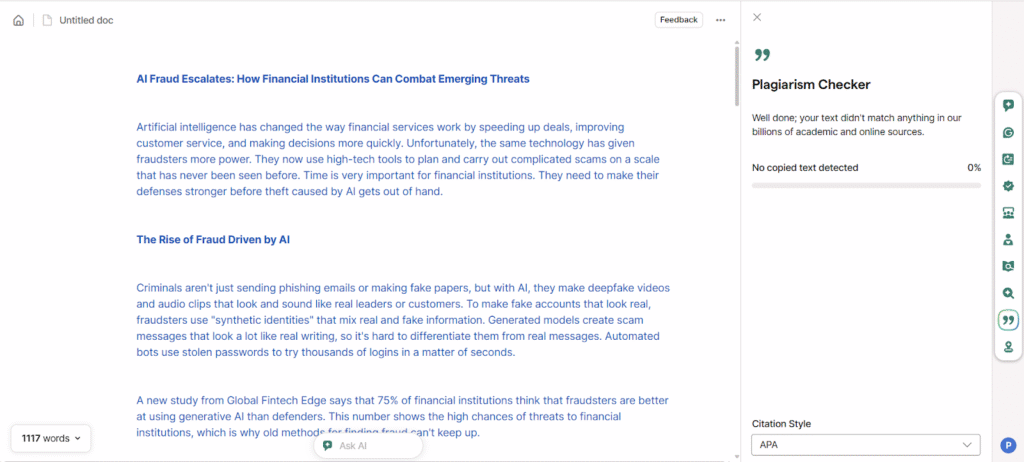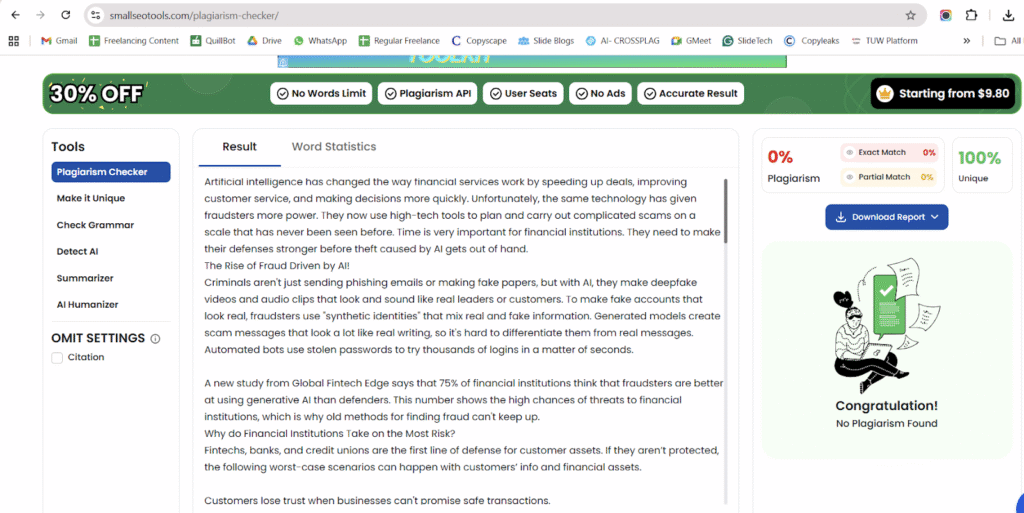AI Fraud Escalates: How Financial Institutions Can Combat Emerging Threats?

Artificial intelligence has changed the way financial services work by speeding up deals, improving customer service, and making decisions more quickly. Unfortunately, the same technology has given fraudsters more power. They now use high-tech tools to plan and carry out complicated scams on a scale that has never been seen before. Time is very important for financial institutions. They need to make their defenses stronger before theft caused by AI gets out of hand.
The Rise of Fraud Driven by AI!
Criminals aren’t just sending phishing emails or making fake papers, but with AI, they make deepfake videos and audio clips that look and sound like real leaders or customers. To make fake accounts that look real, fraudsters use “synthetic identities” that mix real and fake information. Generated models create scam messages that look a lot like real writing, so it’s hard to differentiate them from real messages. Automated bots use stolen passwords to try thousands of logins in a matter of seconds.
A new study from Global Fintech Edge says that 75% of financial institutions think that fraudsters are better at using generative AI than defenders. This number shows the high chances of threats to financial institutions, which is why old methods for finding fraud can’t keep up.

Why do Financial Institutions Take on the Most Risk?
Fintechs, banks, and credit unions are the first line of defense for customer assets. If they aren’t protected, the following worst-case scenarios can happen with customers’ info and financial assets.
- Customers lose trust when businesses can’t promise safe transactions.
- Companies lose more money because of compensation claims, chargebacks, and fixing problems.
- Governments put more pressure on businesses to follow tighter rules.
- The damage to your reputation lasts for a long time after the fraud is over, sending customers to your rivals.
Fraud has become a constant cost for institutions that are slow to adopt modern tactics, rather than a one-time setback.
Emerging Fraud Vectors to Watch
- Voice Cloning and Deepfake Scams
AI is used by attackers to copy sounds or faces amazingly well. They get employees to authorize transfers or sensitive actions by pretending to be bosses or account holders.
- Phishing with AI
Generative models make personalized letters that use real information and copy the way people talk. These emails get past regular spam filters and trick even the most careful workers.
- Making fake IDs and documents
AI makes it possible to make fake IDs, passports, and other documents. These names look real enough to get past systems that check documents or facial recognition.
- Automated Takeover of Account
AI-powered bots can quickly check stolen passwords. They learn how to get around defenses and take advantage of weak spots faster than human researchers can respond to the scam.
- Attacks from the Other Side on AI Models
Some criminals try to trick or poison systems that look for fraud. By changing the data that is entered, they make systems mistakenly think that fraud is a real action.

Strategies That Really Work: What Institutions Can Do to Fight Back?
- Use Fraud Detection Powered by AI
Machine learning is used by modern fraud detection systems to look at transaction trends, device fingerprints, geolocation data, and behavioral signals in real time. These systems don’t just follow rules; they change as new threats appear.
Global Fintech Edge recently wrote about Feedzai’s start of “Feedzai IQ,” a federated learning solution made to find fraud without compromising privacy. Institutions can work together on the site without sharing raw data. Feedzai says it has four times better accuracy in detection and half as many false results. These kinds of progress show that AI can be used to both do and stop crime.
- Make Access and Authentication Controls Stronger
Multi-factor identification, biometric verification, and risk-based checks should all be used by institutions. Continuous authentication, which watches how you use a computer during a session, can stop fraud even if your initial entry is stolen.
- Continuously Watch and Act in Real Time
Monitoring transactions in real time is no longer a choice. Alerts that are set off by strange behavior need to be looked into right away. Fraud is stopped before it does any damage by a layered system that looks at many risk signs.
- Teach Your Employees and Your Customers
Fraud that is driven by AI needs to be taught to employees through drills and simulations. People also need to know about the dangers of voice cloning and scams that look too real to be true. Institutions are less likely to be hacked when clients check sensitive requests through secondary routes.
- Share Information and Work Together
Banks and other financial institutions shouldn’t work alone. By sharing threat information that has been anonymized, they make collective protection possible. What one bank finds today might keep another bank from being hacked tomorrow.
- Make the Ecosystem Stronger
Red teaming, penetration drills, and incident simulations are all ways that institutions must test their systems. Adversarial attacks are less likely to happen when APIs are well-protected and models are updated regularly.
- Adopt Proactive Threat Hunting and AI That can Explain Itself
Also, institutions should be proactive about looking for threats by practicing possible strikes before criminals use them. This method finds weaknesses early on and makes shields stronger. At the same time, AI that can be explained is important. Systems that make it clear why a transaction was flagged help compliance teams and officials do their jobs better. Making decisions in a clear way builds trust in the institution’s defenses.
What Role do Global Rules and Cooperation Across Borders Play?
AI fraud doesn’t care about countries. Criminals can attack institutions in many parts of the world at the same time from anywhere in the world. The government and financial authorities need to work together to set common norms for data security and to detect fraud.
Many kinds of global teamwork are possible. Federated learning lets institutions share information about how to spot scams without sharing private information about their customers. Cross-border deals can make safe data corridors that protect privacy and speed up the fight against new threats. Financial companies can only keep up with how quickly fraud changes if they work together.
To Conclude- Do Something Now to Stay Ahead!
AI scam is already here. The financial sector can’t put it off as a worry for later. They can stay ahead of scammers by putting money into adaptive fraud detection systems, improving authentication, actively looking for threats, and working together across the industry.
The best protection is a mix of alertness, new ideas, and working together around the world. If institutions move quickly today, they will protect their customers and their own futures.
Author Bio – Harikrishna Kundariya
Harikrishna Kundariya, is a marketer, developer, IoT, Cloud & AWS savvy, co-founder, and Director of eSparkBiz, a Software Development Company. His 15+ years of experience enables him to provide digital solutions to new start-ups based on IoT and SaaS applications.
Company’s Bio :
eSparkBiz is a global IT services company specializing in custom software development, mobile app development and IoT app development With a commitment to innovation and client satisfaction, Esparkbiz delivers cutting-edge technology solutions that empower businesses to grow and succeed in the digital era. Known for its skilled team and customer-centric approach, Esparkbiz Technologies serves clients across diverse industries worldwide.



